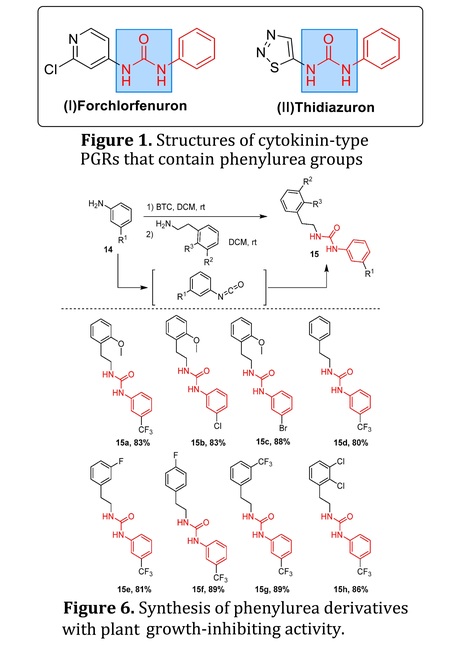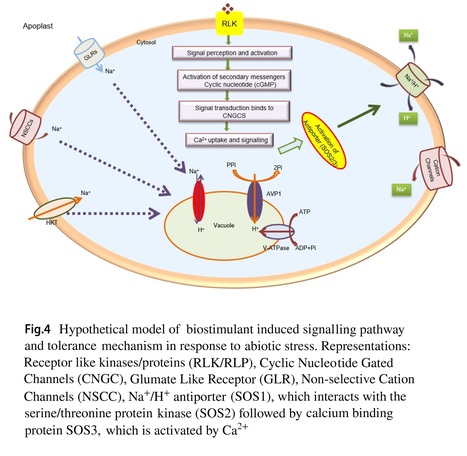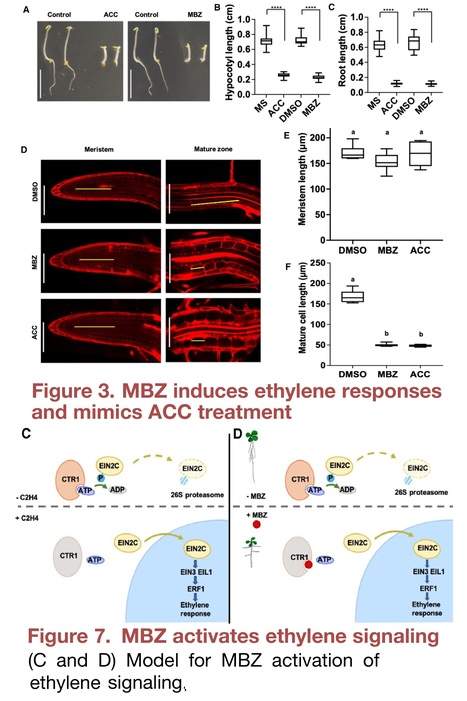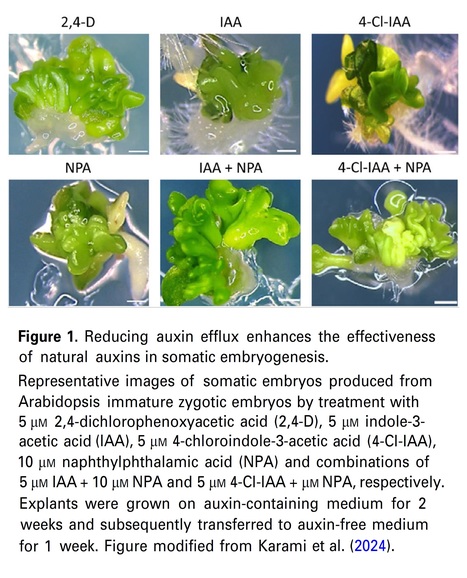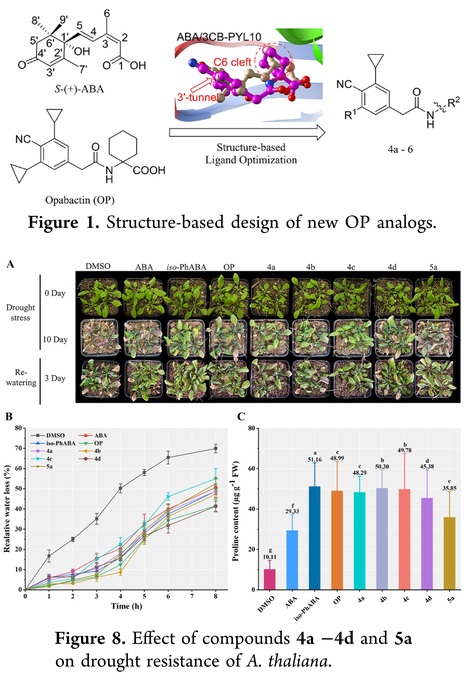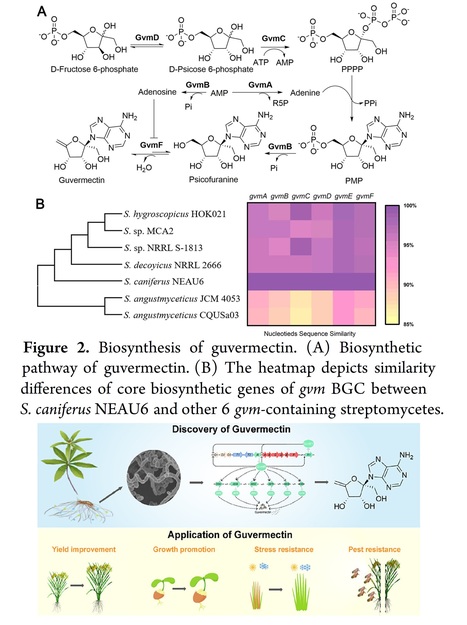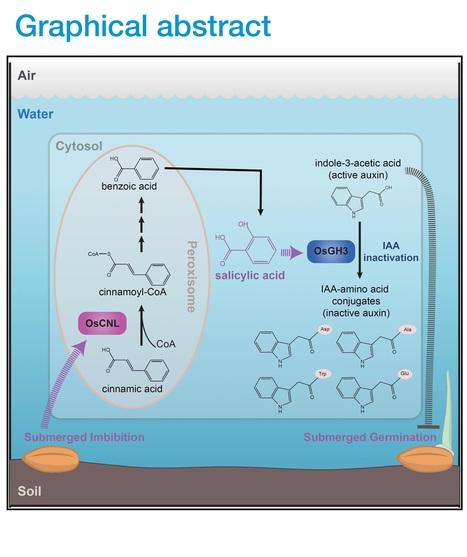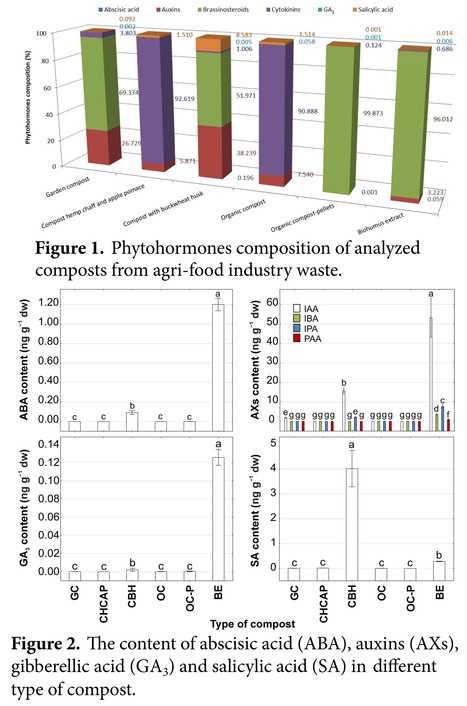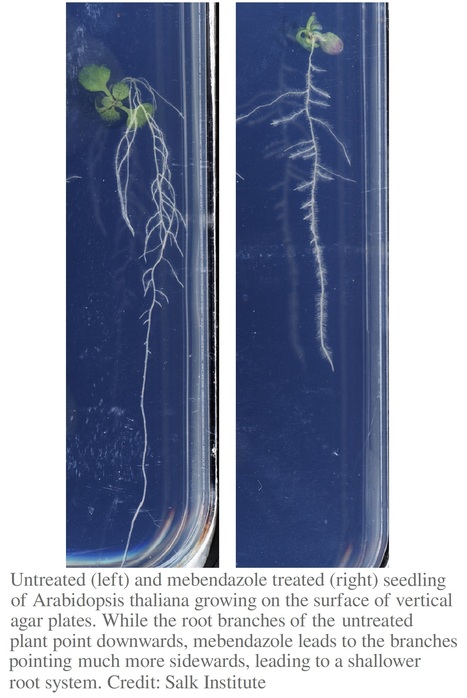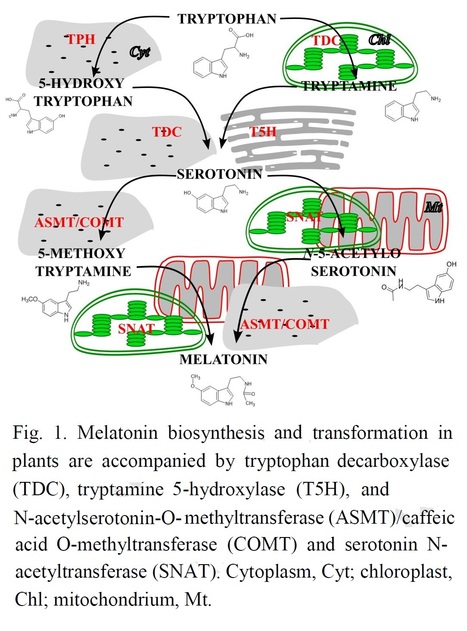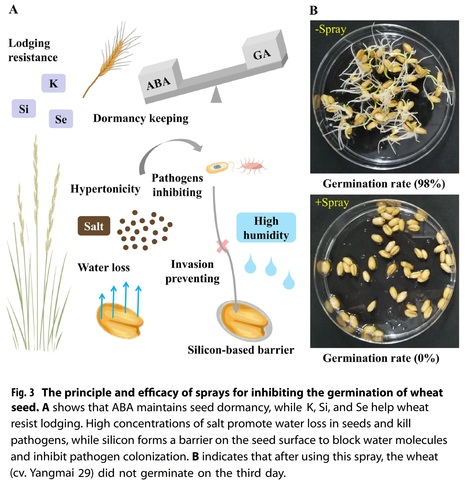 Your new post is loading...
 Your new post is loading...
Authors: Diego Alejandro Gutiérrez-Villamil, Stanislav Magnitskiy and Helber Enrique Balaguera-López.
Postharvest Biology and Technology (2024)
Highlights • BR have a potential signaling function in the regulation of fruit development. • BR are a postharvest technology to regulate the ripening of fruits and vegetables. • BR mitigate chilling injury by increasing antioxidant systems. • BR induce expression genes of defense and immunity against postharvest pathogens.
Abstract: "Fresh horticultural products satisfy the nutritional, and industrial needs of consumers worldwide. However, the lack of understanding of the fruit development process, the accelerated senescence process and the lack of post-harvest technology in some regions, present a threat to the food and economic security of the food agribusiness. Brassinosteroids (BR) are plant hormones involved in the regulation of various physiological processes and have recently proven to be a viable post-harvest technology alternative to regulate the ripening and senescence of fruits and vegetables. In this review, the current state of BR research on fruit growth and development, physicochemical changes during ripening, and biotic-abiotic stress during the post-harvest life of horticultural products is presented. Furthermore, the review encompasses the effect of the application of exogenous BR and its relationship with molecular signaling on the processes mentioned above, including aspects such as methods, moments and BR analogues at the time of application, and the molecular mechanisms involved. This review proposes a basis for research of the physiological aspects of BR regulation in fruits and vegetables during their development and post-harvest period, and also points to a direction for in-depth investigation of the molecular mechanisms."
Authors: Kei Tsuzuki, Taiki Suzuki, Michio Kuruma, Kotaro Nishiyama, Ken-ichiro Hayashi, Shinya Hagihara and Yoshiya Seto.
bioRxiv (2024)
Abstract: "Root parasitic plants in the Orobancheceae, such as Striga and Orobanche, cause significant damage to crop production. The germination step of these root parasitic plants is induced by host-root-derived strigolactones (SLs). After germination, the radicles elongate toward the host and invade the host root. We have previously discovered that a simple amino acid, tryptophan (Trp), as well as its metabolite, the plant hormone indole-3-acetic acid (IAA), can inhibit radicle elongation of Orobanche minor. These results suggest that auxin plays a crucial role in the radicle elongation step in root parasitic plants. In this report, we used various auxin chemical probes to dissect the auxin function in the radicle growth of O. minor and Striga hermonthica. We found that synthetic auxins inhibited radicle elongation. In addition, auxin receptor antagonist, auxinole, rescued the inhibition of radicle growth by exogenous IAA. Moreover, a polar transport inhibitor of auxin, N-1-naphthylphthalamic acid (NPA), affected radicle tropism. We also proved that exogenously applied Trp is converted into IAA in O. minor seeds, and auxinole partly rescued this radicle elongation. Our data demonstrate a pivotal role of auxin in radicle growth. Thus, manipulation of auxin function in root parasitic plants should offer a useful approach to combat these parasites."
Authors: Dongmei Chen, Tianhui Liao, Wenjun Ye, Zhichao Jin and Shichao Ren.
Advanced Agrochem (2024)
Abstract: "Plant growth regulators (PGRs) are chemical substances that imitate the functions of phytohormones to enhance the crop yield and the harvest process. Phenylurea-derived plant growth regulators are known for their excellent efficacy in promoting fruit growth, particularly in kiwifruit, grapes, and melons. Phenylurea derivatives represent one class of the highly efficient and versatile PGRs. Specifically, forchlorfenuron (CPPU, N-(2-chloro-4-pyridinyl)-N’-phenylurea) exhibits similar growth-regulating efficacy to cytokinins and has a significant impact on the plant growth and the crop yield. As a result, there is growing interest in exploring the incorporation of various phenylurea moieties into agrochemicals to enhance their regulatory properties on crops. This review aims to provide a comprehensive overview on representative synthetic approaches for phenylurea derived PGRs. Additionally, we provide our perspective on the future development in this active research field."
Authors: Renata P. Pincelli-Souza, Qian Tang, Brandon M. Miller and Jerry D. Cohen.
Horticultural Advances (2024)
Abstract: "The first reports that auxins promoted root formation in cuttings and that indole-3-butyric acid (IBA) was a particularly effective treatment date from the early 1930s. Since its introduction into horticultural practice, the focus on improvements in the rooting of plants has been largely on the proper use of auxins to enhance adventitious rooting (AR) as well as to increase the range of plants where it can be effective. In this review, we focus on new ideas that might build on what is known about auxin induction of AR. We explore what the evolution in chemical biology has opened through novel high-throughput screening tools to explore auxin regulation of plant development and what it might add to our understanding and potential to produce new tools for the manipulation of AR. The potential for using stronger auxin analogues, alternative indolealkanoic acids, compounds that alter β-oxidation of IBA and other indolealkanoic acids, auxin conjugates, inhibitors of auxin conjugation, inhibitors of endogenous auxin biosynthesis, as well as other plant hormones and compounds that inhibit the production or mimic the effects of signals that might be involved in AR are all discussed. The expectation is that a summary of these advances in our understanding of the chemical biology important to AR might increase the use and exploration of new ideas for the improvement in the practical approaches to advance horticultural rooting methods."
Authors: Lin Du, Xingjia Li, Yimin Ding, Dengke Ma, Chunxin Yu and Liusheng Duan.
Journal of Agricultural and Food Chemistry (2024)
Abstract: "The pernicious parasitism exhibited by root parasitic weeds such as Orobanche and Striga poses substantial peril to agricultural productivity and global food security. This deleterious phenomenon hinges upon the targeted induction of the signaling molecule strigolactones (SLs). Consequently, the identification of prospective SL antagonists holds significant promise in the realm of mitigating the infection of these pernicious weeds. In this study, we synthesized and characterized D12 based on a potent SL antagonist KK094. In vivo assay results demonstrated that D12 remarkably impedes the germination of Phelipanche aegyptiaca and Striga asiatica seeds, while also alleviating the inhibitory consequence of the SL analogue GR24 on hypocotyl elongation in Arabidopsis thaliana. The docking study and ITC assay indicated that D12 can interact strongly with the SL receptor protein, which may interfere with the binding of SL to the receptor protein as a result. In addition, the results of crop safety assessment tests showed that D12 had no adverse effects on rice seed germination and seedling growth and development. The outcomes obtained from the present study suggested that D12 exhibited promise as a prospective antagonist of SL receptors, thereby displaying substantial efficacy in impeding the seed germination process of root parasitic weeds, providing a promising basis for rational design and development of further Striga-specific herbicides."
Authors: Kangning Zhang, Hongli Xie, Jiangqi Wen, Jing Zhang, Zeng-Yu Wang, Bin Xu and Maofeng Chai.
Grass Research (2024)
Abstract: "Leaf senescence is a complex biological process regulated by development, phytohormones, and various environmental factors. For forage and turf grasses, controlling leaf senescence can greatly improve forage quality, the amenity of lawn and turf, and the grasses’ stress tolerances. Leaf senescence involves a multitude of gene regulation and metabolic changes, including the alteration of chlorophyll metabolism. Here, we summarized the recent progress of studies on leaf senescence in major forage and turf grass species, such as Medicago truncatula, M. sativa, Lolium perenne, Panicum virgatum, and Agrostis stolonifera, to provide an insight into the development of effective methods for delaying leaf senescence in grass species."
Authors: Pramod Rathor, Punita Upadhyay, Aman Ullah, Linda Yuya Gorim and Malinda S. Thilakarathna.
AoB Plants (2024)
Abstract: "Humic acids have been widely used for centuries to enhance plant growth and productivity. The beneficial effects of humic acids have been attributed to different functional groups and phytohormone-like compounds enclosed in macrostructure. However, the mechanisms underlying the plant growth-promoting effects of humic acids are only partially understood. We hypothesize that the bio-stimulatory effect of humic acids is mainly due to the modulation of innate pathways of auxin and cytokinin biosynthesis in treated plants. A physiological investigation along with molecular characterization was carried out to understand the mechanism of bio-stimulatory effects of humic acid. A gene expression analysis was performed for the genes involved in auxin and cytokinin biosynthesis pathways in wheat seedlings. Furthermore, Arabidopsis thaliana transgenic lines generated by fusing the auxin-responsive DR5 and cytokinin-responsive ARR5 promoter to ß-glucuronidase (GUS) reporter were used to study the GUS expression analysis in humic acid treated seedlings. This study demonstrates that humic acid treatment improved the shoot and root growth of wheat seedlings. The expression of several genes involved in auxin (Tryptophan Aminotransferase of Arabidopsis and Gretchen Hagen 3.2) and cytokinin (Lonely Guy3) biosynthesis pathways was up-regulated in humic acid treated seedlings compared to the control. Furthermore, GUS expression analysis showed that bioactive compounds of humic acid stimulate endogenous auxin and cytokinin-like activities. This study is the first report in which using ARR5 :GUS lines we demonstrate the biostimulants activity of humic acid."
Authors: Riya Johnson, Joy M. Joel and Jos T. Puthur.
Journal of Plant Growth Regulation (2024)
Abstract: "Anthropogenic activities have led to a surge in the use of synthetic chemical compounds in agriculture, elevating environmental toxicity levels. As a response to this concern, there is a growing demand for environmentally friendly solutions. In recent times, the focus has shifted towards the development of cost-effective and ecologically sound organic products known as biostimulants. These innovative products play a pivotal role in enhancing agricultural productivity by fostering comprehensive plant growth and development. Biostimulants encompass a diverse range of natural and synthetic substances, categorized into microbial, non-microbial, and waste-derived sources. When judiciously applied to crops, these substances exhibit the remarkable ability to enhance plant metabolism, bolster productivity, and enhance resilience to adverse environmental conditions. Through modulation of molecular mechanisms and epigenetic alterations, biostimulants achieve this by influencing critical signalling molecules, transcription factors, and hormonal levels, which collectively contribute to stress tolerance. This review paper delves into the burgeoning industrial interest surrounding biostimulants. It sheds light on their intricate modes and mechanisms of action, encompassing both physiochemical and molecular aspects. Furthermore, the paper underscores the captivating potential of biostimulants to induce trans-generational plasticity and metabolite accumulation within plants, a phenomenon warranting deeper exploration through metabolomics. This review paper focuses on valuable insights into the transformative influence of biostimulants on agricultural practices, showcasing their capacity to usher in a new era of sustainable and resilient crop cultivation."
Authors: Romica Verma, Bhavana Sharma and Gulzar A. Rather.
In book: Strigolactones - Synthesis, Application and Role in Plants (2024)
Abstract: "Strigolactones (SLs) are a class of plant hormones that are derived from carotenoids. They play a crucial function in growth and development and provide strong resilience against specific bacterial and fungal pathogens. The biosynthesis of SLs is severe in response to the stresses that plants face during different developmental processes. SLs are primarily synthesized in the roots, and their prime function is to interact with auxin for the regulation of salinity and drought response. Recently, SLs have been given much consideration due to their vital importance in the maintenance of numerous molecular and physiological adjustments of several plant species under biotic stresses. Moreover, evidence of the interaction between SLs with other phytohormones, mainly abscisic acid, against stress proposes that SLs participate actively in regulating stress in plant systems. Therefore, SLs are potential targets for agricultural crops to enhance their biotic and abiotic stress ability. Hence, the SL-based engineering of plants will provide a considerable archetype shift in the field of crop protection and enhancement by replacing the classical approaches of pests/disease management. Inclusively, this chapter will provide insights into SLs synthesis, signaling, and their role in regulation of biotic and abiotic stresses, and highlight some aspects of SLs function in distinct areas of agriculture."
Authors: James Eckhardt and Sean Cutler.
bioRxiv (2024)
Abstract: "Germination is critical to agricultural productivity because low germination rates and/or asynchronous germination negatively affect stand establishment and subsequent yields. Exposure to high temperatures during seed imbibition can decrease both germination synchrony and rates through an ABA-mediated process called thermoinhibition. Methods to reduce thermoinhibition would be agriculturally valuable, particularly with increasing global mean temperatures. Lettuce seed germination is particularly sensitive to high temperatures and is a classic system for studying thermoinhibition. Extensive evidence using mutants and carotenoid biosynthetic inhibitors (e.g. fluridone) has demonstrated that endogenous abscisic acid (ABA) biosynthesis is required for thermoinhibition in lettuce and Arabidopsis. In principle, ABA biosynthetic inhibitors could be used to block thermoinhibition, but carotenoid biosynthetic inhibitors are not well-suited for this application due to their herbicidal effects and current hydroxamate ABA biosynthetic inhibitors lack potency. Here we explore the potential of ABA receptor antagonism to disrupt thermoinhibition using Antabactin (ANT), a broad spectrum high-affinity receptor antagonist. We show low μM ANT treatments (10μM) during seed imbibition reduce thermoinhibition at temperatures of up to 40°C, demonstrating that ABA signaling is required for thermoinhibition. We further explored interactions between ANT and seed priming, which is used commercially to improve seed germination and reduce thermoinhibition and is achieved by partial hydration and subsequent desiccation of seeds. We show that primed lettuce seeds have improved germination rates at high temperatures, consistent with previous observations; moreover, seeds primed in the presence of ANT show further increases in germination at elevated temperatures, showing that the two treatments can be combined to improve lettuce seed germination. Our data demonstrate that ABA antagonists are candidate agrochemicals for mitigating the effects of high temperature on seed germination and stand establishment that may be of increasing importance due to climate change."
Authors: Wenrong He (何文容), Hai An Truong, Ling Zhang (张凌), Min Cao (曹珉), Neal Arakawa, Yao Xiao (肖瑶), Kaizhen Zhong (钟开珍), Yingnan Hou (侯英楠) and Wolfgang Busch.
Cell Reports (2024)
Editor's view: He et al. identify a small molecule that regulates lateral root angle. They show that the compound increases lateral root angle by inhibiting CTR1 kinase activity, which in turn activates ethylene signaling. Therefore, they show that the ethylene pathway is involved in lateral root angle regulation.
Highlights: • MBZ increases lateral root angle • MBZ regulates lateral root angle by activating ethylene signaling • MBZ inhibits CTR1 kinase activity • The ethylene pathway is involved in lateral root angle regulation
Abstract: "The lateral root angle or gravitropic set-point angle (GSA) is an important trait for root system architecture (RSA) that determines the radial expansion of the root system. The GSA therefore plays a crucial role for the ability of plants to access nutrients and water in the soil. Only a few regulatory pathways and mechanisms that determine GSA are known. These mostly relate to auxin and cytokinin pathways. Here, we report the identification of a small molecule, mebendazole (MBZ), that modulates GSA in Arabidopsis thaliana roots and acts via the activation of ethylene signaling. MBZ directly acts on the serine/threonine protein kinase CTR1, which is a negative regulator of ethylene signaling. Our study not only shows that the ethylene signaling pathway is essential for GSA regulation but also identifies a small molecular modulator of RSA that acts downstream of ethylene receptors and that directly activates ethylene signaling."
Authors: Saleem Uddin, Muhammad Zeeshan Munir, Eduardo Larriba, José Manuel Pérez-Pérez, Sadia Gull, Tariq Pervaiz, Umer Mahmood, Zahid Mahmood, Yuhan Sun and Yun Li.
Planta (2024)
Main conclusion Optimal levels of indole-3-butyric acid (IBA) applied at the stem base promote adventitious root (AR) initiation and primordia formation, thus promoting the rooting of leafy micro-cuttings of tetraploid Robinia pseudoacacia.
Abstract: "Tetraploid Robinia pseudoacacia L. is a widely cultivated tree in most regions of China that has a hard-rooting capability, propagated by stem cuttings. This study utilizes histological, physiological, and transcriptomic approaches to explore how root primordia are induced after indole butyric acid (IBA) treatment of micro-cuttings. IBA application promoted cell divisions in some cells within the vasculature, showing subcellular features associated with adventitious root (AR) founder cells. The anatomical structure explicitly showed that AR initiated from the cambium layer and instigate the inducible development of AR primordia. Meanwhile, the hormone data showed that similar to that of indole-3-acetic acid, the contents of trans-zeatin and abscisic acid peaked at early stages of AR formation and increased gradually in primordia formation across the subsequent stages, suggesting their indispensable roles in AR induction. On the contrary, 24-epibrassinolide roughly maintained at extremely high levels during primordium initiation thoroughly, indicating its presence was involved in cell-specific reorganization during AR development. Furthermore, antioxidant activities transiently increased in the basal region of micro-cuttings and may serve as biochemical indicators for distinct rooting phases, potentially aiding in AR formation. Transcriptomic analysis during the early stages of root formation shows significant downregulation of the abscisic acid and jasmonate signaling pathways, while ethylene and cytokinin signaling seems upregulated. Network analysis of genes involved in carbon metabolism and photosynthesis indicates that the basal region of the micro-cuttings undergoes rapid reprogramming, which results in the breakdown of sugars into pyruvate. This pyruvate is then utilized to fuel the tricarboxylic acid cycle, thereby sustaining growth through aerobic respiration. Collectively, our findings provide a time-course morphophysiological dissection and also suggest the regulatory role of a conserved auxin module in AR development in these species."
Authors: Chao Tan, Suxin Li, Jia Song, Xianfu Zheng, Hao Zheng, Weichang Xu, Cui Wan, Tan Zhang, Qiang Bian and Shuzhen Men.
Communications Biology (2024)
Editor's view: Physiological and molecular studies have shown that 3,4-dichlorophenylacetic acid (Dcaa) has auxin-like activity and acts through the auxin signaling pathway in plants. This provides a basis for the application of Dcaa in agricultural practice.
Abstract: "Auxins and their analogs are widely used to promote root growth, flower and fruit development, and yield in crops. The action characteristics and application scope of various auxins are different. To overcome the limitations of existing auxins, expand the scope of applications, and reduce side effects, it is necessary to screen new auxin analogs. Here, we identified 3,4-dichlorophenylacetic acid (Dcaa) as having auxin-like activity and acting through the auxin signaling pathway in plants. At the physiological level, Dcaa promotes the elongation of oat coleoptile segments, the generation of adventitious roots, and the growth of crop roots. At the molecular level, Dcaa induces the expression of auxin-responsive genes and acts through auxin receptors. Molecular docking results showed that Dcaa can bind to auxin receptors, among which TIR1 has the highest binding activity. Application of Dcaa at the root tip of the DR5:GUS auxin-responsive reporter induces GUS expression in the root hair zone, which requires the PIN2 auxin efflux carrier. Dcaa also inhibits the endocytosis of PIN proteins like other auxins. These results provide a basis for the application of Dcaa in agricultural practices."
|
Authors: Faisal Zulfiqar, Anam Moosa, Hayssam M. Ali, Núria F. Bermejo and Sergi Munné-Bosch.
Plant Physiology and Biochemistry (2024)
Highlights: • Biostimulants are biobased solutions to tackle modern agriculture problems • For tackling climate change issue, biostimulants are not enough • Stopping wars and conflicts is the main solution to save environment and agriculture
Abstract: "Climate change is currently one of the main concerns of the agricultural sector, as it limits crop production and quality. Furthermore, the current context of global crisis with international political instability and war conflicts over the world is pushing the agricultural sector even more to urgently boost productivity and yield and doing so in a sustainable way in the current frame of climate change. Biostimulants can be an effective tool in alleviating the negative effects of environmental stresses to which plants are exposed, such as drought, salinity, heavy metals and extreme temperatures. Biostimulants act through multiple mechanisms, modifying gene expression, metabolism and phytohormone production, promoting the accumulation of compatible solutes and antioxidants and mitigating oxidative stress. However, it is important to keep in mind that the use and effect of biostimulants has limitations and must be accompanied by other techniques to ensure crop yield and quality in the current frame of climate change, such as proper crop management and the use of other sustainable resources. Here, we will not only highlight the potential use of biostimulants to face future agricultural challenges, but also take a critical look at their limitations, underlining the importance of a broad vision of sustainable agriculture in the current context of climate change."
Author: Martin Balcerowicz
The Plant Journal (2024)
Excerpts: " The synthetic auxin 2,4-dichlorophenoxyacetic acid (2,4-D) stands out as the most effective inducer of somatic embryogenesis, whereas other synthetic auxins like 1-naphthaleneacetic acid (1-NAA) and natural auxins such as indole-3-acetic acid (IAA) yield inferior results (Gaj, 2004). However, the underlying reasons for 2,4-D's superior efficacy have remained elusive."
"He observed that 2,4-D is perceived by the same canonical auxin signalling pathway that senses IAA, suggesting that the superior effectiveness of 2,4-D is not due to differences in perception or signalling (Karami et al., 2023). However, 2,4-D differs in its cellular availability, accumulating to higher levels within plant cells and exhibiting lower efficiency as a substrate for auxin efflux carriers than IAA (Delbarre et al., 1996; Seifertová et al., 2014). In the highlighted study, Karami and colleagues investigated whether these properties contribute to making 2,4-D a potent inducer of somatic embryogenesis."
"Given that 2,4-D is a poor substrate for auxin efflux, they examined the impact of the auxin efflux inhibitor naphthylphthalamic acid (NPA) on the efficacy of various synthetic and natural auxins to induce embryo formation. Strikingly, combined treatment with IAA and NPA was as effective in generating somatic embryos as treatment with 2,4-D (Figure 1). NPA also enhanced the efficacy of other natural and synthetic auxins, with highest embryo numbers observed for a combination of 4-chloroindole-3-acetic acid (4-Cl-IAA) and NPA. Monitoring the expression of a pDR5::GUS auxin reporter showed that combined treatment of IAA or synthetic auxins with NPA elicited a stronger auxin response than treatment with either compound alone. These observations demonstrate that many auxins can efficiently induce somatic embryogenesis when auxin efflux is inhibited, likely due to increased intracellular auxin levels."
Authors: Xianjun Tang, Minghui Chen, Xiaobin Li, Xueqin Zhang*, Ping Wang, Yanjun Xu, Jiaqi Li and Zhaohai Qin.
Journal of Agricultural and Food Chemistry (2024)
Abstract: "Abscisic acid (ABA), a phytohormone, and its analogs have been found to enhance plant resistance to various biotic and abiotic stresses, particularly drought, by activating the ABA signaling pathway. This study used a combination of structure-directed design and molecular docking screening methods to synthesize a novel series of opabactin (OP) analogs. Among them, compounds 4a–4d and 5a showed comparable or superior activity to OP in bioassays, including seed germination and seedling growth inhibition in A. thaliana and rice, stomatal closure, and drought resistance in wheat and soybean. Further transcriptome analysis revealed distinct mechanisms of action between compound 4c and iso-PhABA in enhancing drought tolerance in A. thaliana. These findings highlight the application prospect of 4c and its analogs in agricultural cultivation, particularly in drought resistance. Additionally, they provide new insights into the mechanisms by which different ABA receptor agonists enhance drought resistance."
Authors: Chongxi Liu, Manman Zhang, Lei Li, Xiangjing Wang, Shanshan Li and Wensheng Xiang.
Journal of Agricultural and Food Chemistry (2024)
Abstract: "Plant growth regulators (PGRs) play an important role in alleviating the detrimental effects of biotic and abiotic stress and improving crop yield and quality. As a novel PGR from Streptomyces registered in 2021, guvermectin (GV) has the potential to improve plant yield and defense, making its application in agriculture a subject of interest. Here, we describe the discovery process, functional activities, agricultural applications, toxicity, environmental safety, and biosynthetic mechanism of GV. This Perspective provides a guide for the development of novel PGRs from microorganisms."
Authors: Yukang Wang, Gaochen Jin, Shuyan Song, Yijun Jin, Xiaowen Wang, Shuaiqi Yang, Xingxing Shen, Yinbo Gan, Yuexing Wang, Ran Li, Jian-Xiang Liu, Jianping Hu and Ronghui Pan.
Developmental Cell (2024)
Editor's view: Wang et al. demonstrated a peroxisomal cinnamate:CoA ligase (CNL)-dependent phytohormone metabolic cascade in rice. Submerged imbibition-induced salicylic acid (SA) biosynthesis promotes anaerobic germination by inducing OsGH3-mediated indole-acetic acid (IAA)-amino acid conjugation, thus releasing IAA’s inhibition of germination under water submergence conditions.
Highlights: • OsCNLs are induced in rice submerged imbibition to synthesize salicylic acid (SA) • Peroxisomal OsCNLs are key enzymes in the SA biosynthetic pathway in rice • SA promotes submerged germination via OsGH3-mediated indole-acetic acid catabolism • SA pretreatment is a cost-effective strategy to improve rice submerged germination
Abstract: "The mechanism underlying the ability of rice to germinate underwater is a largely enigmatic but key research question highly relevant to rice cultivation. Moreover, although rice is known to accumulate salicylic acid (SA), SA biosynthesis is poorly defined, and its role in underwater germination is unknown. It is also unclear whether peroxisomes, organelles essential to oilseed germination and rice SA accumulation, play a role in rice germination. Here, we show that submerged imbibition of rice seeds induces SA accumulation to promote germination in submergence. Two submergence-induced peroxisomal Oryza sativa cinnamate:CoA ligases (OsCNLs) are required for this SA accumulation. SA exerts this germination-promoting function by inducing indole-acetic acid (IAA) catabolism through the IAA-amino acid conjugating enzyme GH3. The metabolic cascade we identified may potentially be adopted in agriculture to improve the underwater germination of submergence-intolerant rice varieties. SA pretreatment is also a promising strategy to improve submerged rice germination in the field."
Authors: Lin Du, Xingjia Li, Yimin Ding, Dengke Ma, Chunxin Yu, Hanqing Zhao, Ye Wang, Ziyan Liu and Liusheng Duan.
International Journal of Molecular Sciences (2024)
Abstract: "Strigolactones (SLs) are plant hormones that regulate several key agronomic traits, including shoot branching, leaf senescence, and stress tolerance. The artificial regulation of SL biosynthesis and signaling has been considered as a potent strategy in regulating plant architecture and combatting the infection of parasitic weeds to help improve crop yield. DL1b is a previously reported SL receptor inhibitor molecule that significantly promotes shoot branching. Here, we synthesized 18 novel compounds based on the structure of DL1b. We performed rice tillering activity assay and selected a novel small molecule, C6, as a candidate SL receptor inhibitor. In vitro bioassays demonstrated that C6 possesses various regulatory functions as an SL inhibitor, including inhibiting germination of the root parasitic seeds Phelipanche aegyptiaca, delaying leaf senescence and promoting hypocotyl elongation of Arabidopsis. ITC analysis and molecular docking experiments further confirmed that C6 can interact with SL receptor proteins, thereby interfering with the binding of SL to its receptor. Therefore, C6 is considered a novel SL receptor inhibitor with potential applications in plant architecture control and prevention of root parasitic weed infestation."
Authors: Aneta Sienkiewicz, Małgorzata Krasowska, Małgorzata Kowczyk-Sadowy, Sławomir Obidziński, Alicja Piotrowska-Niczyporuk and Andrzej Bajguz
Scientific Reports (2024)
Abstract: "Utilizing the organic fraction of agri-food industry waste for fertilization represents one approach to waste management, with composting emerging as a popular method. Composts derived from this waste may contain plant hormones alongside primary macronutrients. This study aimed to evaluate the content of plant hormones in composts crafted from the organic fraction of agri-food industry waste. The presence of these substances was ascertained using liquid chromatography–mass spectrometry (LC-MS) analysis, applied to extracted samples from three composts produced in a bioreactor and three obtained from companies. The results indicate the presence of 35 compounds, which belong to six types of plant hormones: auxins, cytokinins, gibberellins, brassinosteroids, abscisic acid, and salicylic acid, in composts for the first time. The highest amount of plant hormones was noted in buckwheat husk and biohumus extract (35 compounds), and the lowest in hemp chaff and apple pomace (14 compounds). Brassinosteroids (e.g., brassinolide, 28-homobrassinolide, 24-epicastasterone, 24-epibrassinolide, and 28-norbrassinolide) and auxins (e.g., indolilo-3-acetic acid) are dominant. The highest concentration of total phytohormones was reported in biohumus extract (2026.42 ng g−1 dry weight), and the lowest in organic compost (0.18 ng g−1 dry weight)."
Authors: Yu-Lan Zhang, Li-Ying Wang, Yi Yang, Xu Zhao, Hong-Wei Zhu, Chen You, Ning Chen, Shuai-Jie Wei, Shu-Fen Li and Wu-Jun Gao.
The Plant Journal (2024)
Significance Statement: Using environmental factors such as hormones to induce sex conversion is an important approach to studying dioecy sex differentiation, which is a special character closely related to flowering, reproduction, and fruiting. In our research, exogenous GA3 can induce functional masculinization of individual spinach, and the GA-regulating pathway was established: GA-SpGAI-SpSTM-SpPI. This study provides new ideas and theoretical support for studying the sex differentiation mechanisms of spinach and other dioecious plants.
Abstract: "The sex of dioecious plants is mainly determined by genetic factors, but it can also be converted by environmental cues such as exogenous phytohormones. Gibberellic acids (GAs) are well-known inducers of flowering and sexual development, yet the pathway of gibberellin-induced sex conversion in dioecious spinach (Spinacia oleracea L.) remains elusive. Based on sex detection before and after GA3 application using T11A and SSR19 molecular markers, we confirmed and elevated the masculinization effect of GA on a single female plant through exogenous applications of GA3, showing complete conversion and functional stamens. Silencing of GIBBERELLIC ACID INSENSITIVE (SpGAI), a single DELLA family protein that is a central GA signaling repressor, results in similar masculinization. We also show that SpGAI can physically interact with the spinach KNOX transcription factor SHOOT MERISTEMLESS (SpSTM), which is a homolog of the flower meristem identity regulator STM in Arabidopsis. The silencing of SpSTM also masculinized female flowers in spinach. Furthermore, SpSTM could directly bind the intron of SpPI to repress SpPI expression in developing female flowers. Overall, our results suggest that GA induces a female masculinization process through the SpGAI-SpSTM-SpPI regulatory module in spinach. These insights may help to clarify the molecular mechanism underlying the sex conversion system in dioecious plants while also elucidating the physiological basis for the generation of unisexual flowers so as to establish dioecy in plants."
Authors: George Heslop-Harrison, Kazumi Nakabayashi, Ana Espinosa-Ruiz, Francesca Robertson, Robert Baines, Christopher R.L. Thompson, Katrin Hermann, David Alabadí, Gerhard Leubner-Metzger and Robin S.B. Williams.
Plant Communications (2024)
Abstract: "Allelochemicals represent a class of natural products released by plants as root, leaf, and fruit exudates that interfere with the growth and survival of neighboring plants. Understanding how allelochemicals function to regulate plant responses may provide valuable new approaches to better control plant function. One such allelochemical, Myrigalone A (MyA) produced by Myrica gale, inhibits seed germination and seedling growth through an unknown mechanism. Here, we investigate MyA using the tractable model Dictyostelium discoideum and reveal that its activity depends on the conserved homolog of the plant ethylene synthesis protein 1-aminocyclopropane-1-carboxylic acid oxidase (ACO). Furthermore, in silico modeling predicts the direct binding of MyA to ACO within the catalytic pocket. In D. discoideum, ablation of ACO mimics the MyA-dependent developmental delay, which is partially restored by exogenous ethylene, and MyA reduces ethylene production. In Arabidopsis thaliana, MyA treatment delays seed germination, and this effect is rescued by exogenous ethylene. It also mimics the effect of established ACO inhibitors on root and hypocotyl extension, blocks ethylene-dependent root hair production, and reduces ethylene production. Finally, in silico binding analyses identify a range of highly potent ethylene inhibitors that block ethylene-dependent response and reduce ethylene production in Arabidopsis. Thus, we demonstrate a molecular mechanism by which the allelochemical MyA reduces ethylene biosynthesis and identify a range of ultrapotent inhibitors of ethylene-regulated responses."
In: phys.org (February 14, 2024)
Excerpts: "Now, Salk scientists have determined how a well-known plant hormone is crucial in controlling the angle at which roots grow. The study, published in Cell Reports, is the first time the hormone, called ethylene, has been shown to be involved in regulating lateral root angles that shape root systems—making the findings a revelation for plant scientists optimizing root systems."
""Deep roots lead to more durable carbon storage in the soil and can make plants more resistant to drought, so the ability to control how deep roots grow is really exciting for scientists looking to engineer better root systems," says senior author Wolfgang Busch, professor, executive director of the Harnessing Plants Initiative, and Hess Chair in Plant Science at Salk."
"The team observed that genes throughout the ethylene signaling pathway were activated in response to mebendazole, and, in turn, the pathway was carrying out the resulting changes in root growth. Biochemical investigation of this relationship revealed that mebendazole inhibits the activity of a protein kinase called CTR1. This enzyme negatively regulates ethylene signaling, in turn promoting a shallow root system."
Authors: Izabela Kołodziejczyk and Andrzej Kaźmierczak.
Science of the Total Environment (2024)
Highlights: • Melatonin is a plant biostimulator with promising application potential. • Melatonin is a conserved molecule that performs important functions in all organisms. • As a phytobiostimulant, it upregulates plant growth and development and increases plant tolerance to environmental stresses and thus resistance to unfavourable conditions. • Melatonin may allow human-desired cultivations to be maintained in good condition without introducing unnatural compounds into the environment.
Abstract:"MEL (N-acetyl-5-methoxytryptamine) is a well-known natural compound that controls cellular processes in both plants and animals and is primarily found in plants as a neurohormone. Its roles have been described very broadly, from its antioxidant function related to the photoperiod and determination of seasonal rhythms to its role as a signalling molecule, imitating the action of plant hormones (or even being classified as a prohormone). MEL positively affects the yield and survival of plants by increasing their tolerance to unfavourable biotic and abiotic conditions, which makes MEL widely applicable in ecological farming as a stimulant of growth and development. Thus, it is called a phytobiostimulator. In this review, we discuss the genesis of MEL functions, the presence of MEL at the cellular level and its effects on gene expression and plant development, which can ensure the survival of plants under the conditions they encounter. Moreover, we consider the future application possibilities of MEL in agriculture."
Authors: Zhihao Pang and Yongchao Liang.
npj Sustainable Agriculture (2024)
Abstract: "Abnormal weather at harvest time results in wheat lodging and post-harvest sprouting in China’s main wheat-producing areas. Measures such as promoting resistant varieties, using mechanical equipment for harvesting, spraying agents to prevent sprouting, timely storage and drying, screening of already sprouted seeds, timely drainage for farmlands, and full utilization of drying sites can salvage wheat losses. In addition, we have publicly released a spray formula consisting of potassium chloride, abscisic acid, organosilicone, and sodium selenite. This formula is effective and economical for inhibiting wheat germination in high-humidity environments."
|




 Your new post is loading...
Your new post is loading...


